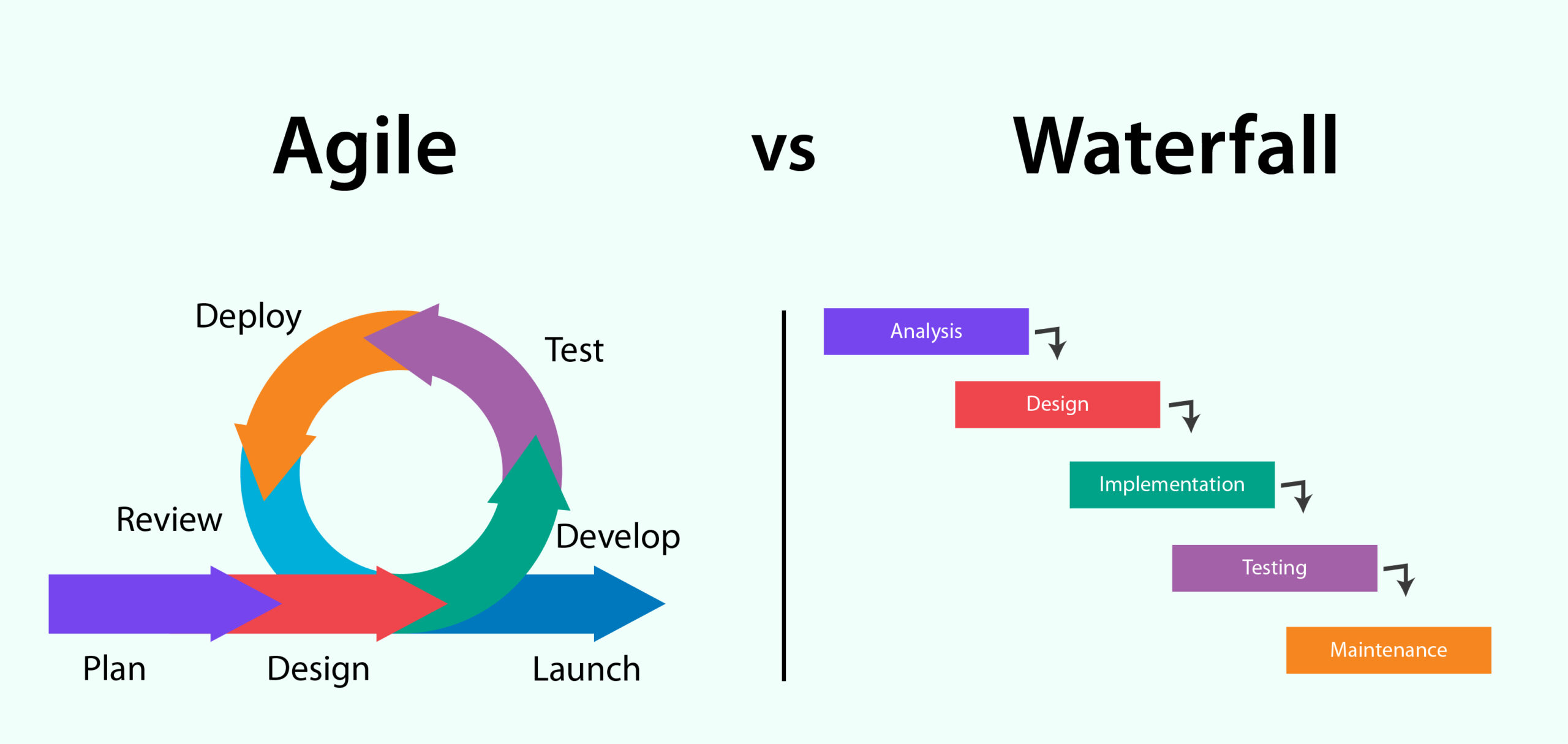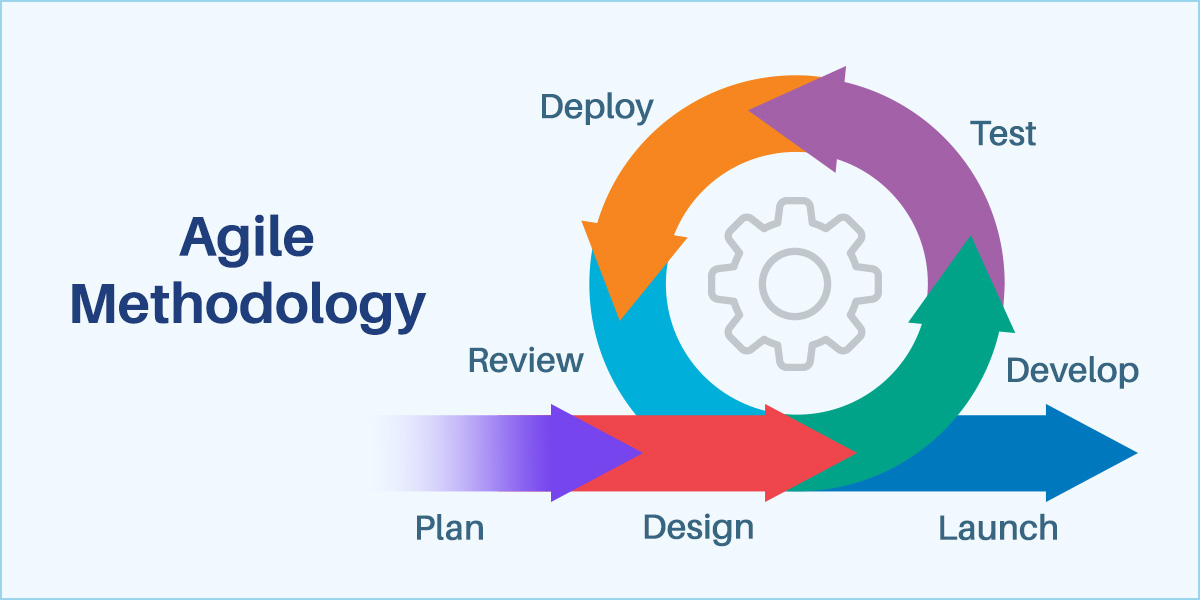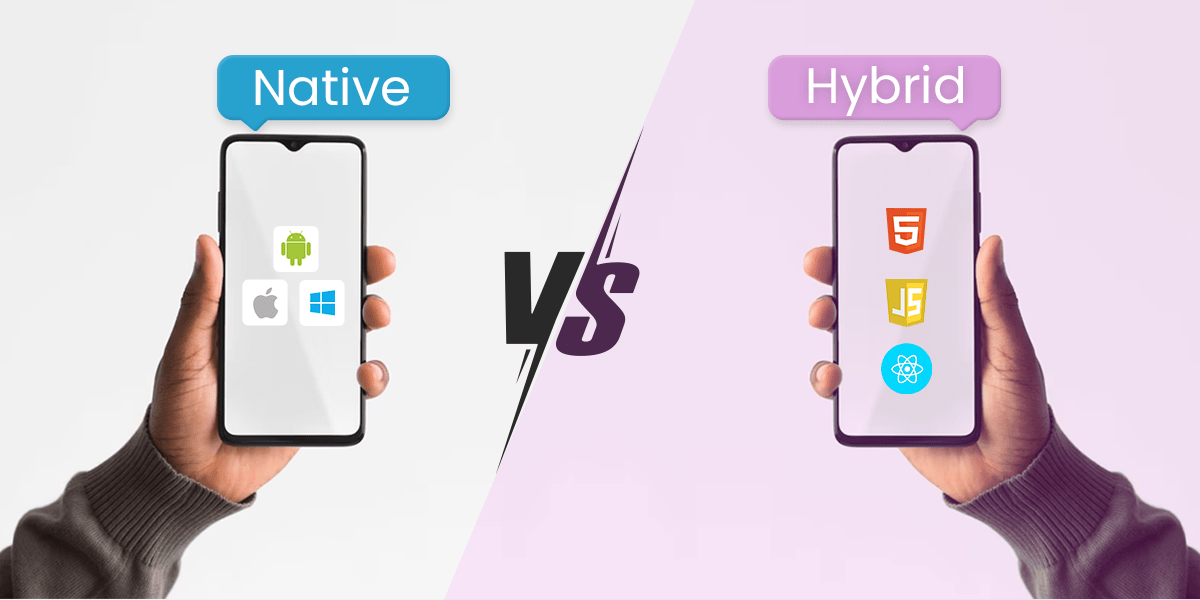What is Agile Software Development Methodology?
Agile software development methodology is a way of managing projects that makes teams work better and projects succeed more often. It’s mostly used in making software and is all about being flexible, making customers happy, and everyone working closely together.
Agile software development stands out for its emphasis on flexibility, customer satisfaction, and collaborative work dynamics. It revolves around the implementation of a specific set of principles, operating through an interactive and incremental framework. Agile software development methodology underscores the significance of team collaboration and swift delivery of functional products to align with customer needs and expectations.
The Evolution of Agile: From Origins to Modern Practice
Agile Software Development Methodology has revolutionized the way software is developed and delivered, transitioning from rigid, linear approaches to more flexible, iterative, and collaborative practices. Here’s a concise journey of its evolution:
1970s – Waterfall Model: The Waterfall model, a sequential approach, dominated this era. Its rigid framework, however, struggled with adapting to changes, often leading to delays.
1980s – Iterative and Incremental Development: Recognizing the limitations of Waterfall, the industry began exploring iterative and incremental development, which allowed for gradual improvements and adaptability.
1990s – Introduction of Scrum: The Scrum methodology emerged, emphasizing teamwork, regular feedback, and the ability to adapt to changing requirements, enhancing the Agile Software Development Methodology.
Late 1990s – Extreme Programming (XP): XP introduced practices like pair programming and test-driven development, further refining Agile approaches with a focus on quality and responsiveness.
2001 – Agile Manifesto: The Agile Manifesto, crafted by leading developers, marked a pivotal moment, solidifying the core values and principles of Agile Software Development Methodology.
2000s to Present – Expansion and Evolution: Agile software development has since become mainstream in software development, with methodologies like Kanban and DevOps building upon Agile principles to improve efficiency, collaboration, and customer satisfaction.
Agile Software Development Methodology’s evolution reflects an ongoing shift towards more dynamic, team-centric, and customer-focused approaches in software development.
What is Agile used for?
The Agile Software Development Methodology isn’t just for creating software. Its main idea is to focus on teamwork and meeting customer needs, and it can be used in many different areas, from big companies to individual freelancers. Agile methods like Scrum and Kanban are especially useful in some fields, but the flexibility, speed, and focus on doing things efficiently that come with Agile are helpful in a wide range of jobs. Basically, Agile software development methodology helps teams work better together and make their customers happier, no matter what kind of work they’re doing.
Agile Software Development Methodology isn’t just a powerful approach for software teams but a versatile strategy that enhances work across various domains by promoting adaptability, rapid iteration, and customer-centric designs. Let’s simplify its benefits in different areas
Software Development
Agile makes creating software faster and more flexible. It allows teams to change their plans easily to make sure they’re always working on what’s most important. This is great for keeping up with new technology and making sure the software does exactly what users need.
Leadership and Management
When bosses use Agile methodology, they help teams work together better and solve problems faster. It makes the workplace happier because everyone knows what they’re doing and feels like they’re part of a team. This means better work gets done, and everyone stays focused on what customers want.
Product Design
Designers using Agile can keep tweaking their products based on what people say they want. This means they can keep improving until they get it just right, making sure the product fits perfectly with what users are looking for.
Agile vs. Waterfall Software Development Methodology: What’s the Difference?

Agile vs. waterfall methodology represents a fundamental choice in software development methodologies, each with its own distinct approach, advantages, and ideal use cases. Understanding the differences between these methodologies is crucial for teams and organizations to select the one that best suits their project’s requirements, team dynamics, and overall goals.
Agile software development is a flexible, iterative approach that emphasizes continuous delivery, customer feedback, and adapting to change. It breaks the project into small, manageable portions, allowing teams to adjust direction based on client feedback and project evolution. This method promotes collaboration, cross-functionality, and transparency, with an emphasis on delivering functional product increments rapidly and efficiently.
Waterfall software development, conversely, is a more traditional, linear approach that follows a strict sequence of phases: requirements, design, implementation, testing, deployment, and maintenance. Each phase must be completed before moving on to the next, with little room for revisiting earlier phases. This method suits projects with well-defined requirements and where changes are unlikely or costly to implement after the project starts.
Advantages of Agile Software Development Methodology
Agile software development methodology comes packed with advantages that make it a popular choice for projects, especially in fast-moving and complex environments. Here’s the benefits of agile software development methodology:
Flexibility and Adaptability: Agile allows teams to adapt to changes quickly. Whether it’s shifting market demands or new customer feedback, Agile makes it easy to adjust the project’s direction without derailing the entire process.
Increased Product Quality: Thanks to continuous testing, regular feedback, and iterative development, Agile helps ensure a high quality of the final product. Each iteration is tested and reviewed, allowing teams to identify and fix issues promptly.
Higher Customer Satisfaction: Agile involves customers in the development process, allowing them to see progress, make suggestions, and have their needs met in real-time. This collaborative approach leads to products that truly meet customer expectations.
Improved Project Control: With regular check-ins, sprints, and reviews, Agile offers more transparency and control over the project. Stakeholders have a clear view of progress and can make informed decisions quickly.
Risk Reduction: Agile’s iterative nature means risks are identified and addressed early in the process. This early detection reduces the likelihood of major failures and ensures the project stays on track.
Faster Time to Market: By breaking down the project into manageable units, teams can focus on delivering value quickly. This approach not only accelerates development but also enables businesses to benefit from faster product launches.
Better Team Morale: Agile promotes a collaborative and empowering work environment. Teams have autonomy over their work, which boosts morale, encourages innovation, and increases productivity.
Efficient Use of Resources: Agile helps in optimizing resources as work is planned and executed in sprints, allowing teams to allocate time and budget more effectively.
Continuous Improvement: Regular retrospectives encourage teams to reflect on what worked, what didn’t, and how processes can be improved, fostering a culture of continuous improvement.
Alignment with Business Goals: Agile ensures that development efforts are aligned with business goals and customer needs, maximizing the project’s value and return on investment.
Challenges in Agile Software Development methodology
While Agile Software Development Methodology offers numerous benefits, it also comes with its set of challenges. Understanding these can help teams prepare and address them effectively. Here’s a rundown in simple terms:
Change Resistance: Some team members and organizations might resist changing from traditional methods to Agile. This resistance can slow down the adoption process and reduce its effectiveness.
High Demand for Collaboration: Agile requires constant communication and collaboration among all team members and stakeholders. For teams not used to this level of interaction, it can be overwhelming and difficult to manage.
Lack of Commitment: Agile projects need full commitment from everyone involved. If team members or stakeholders aren’t fully on board, it can lead to missed deadlines and incomplete projects.
Difficulty in Scaling: While Agile is great for small to medium-sized teams, applying it to larger groups or across entire organizations can be challenging. Finding the right balance between flexibility and control becomes harder as more people get involved.
Overemphasis on Delivery Speed: Focusing too much on quick deliveries can sometimes compromise the quality of the work. Teams need to find a balance between speed and maintaining high standards.
Best Practices for Implementing Agile in Your Business
To implement Agile in your business successfully, follow these simple steps:
Build a Team Culture: Encourage everyone to work together openly and be ready to adapt to changes. This helps in creating a strong team spirit focused on collaboration and flexibility.
Set Clear Goals: Make sure everyone knows what they’re aiming for and understands how their work helps the customer. This keeps the team focused and aligned on what’s important.
Break It Down: Divide your projects into smaller parts (sprints or iterations) with specific goals and deadlines. This makes big tasks more manageable and allows for regular check-ins on progress.
Talk Every Day: Have quick daily meetings (stand-ups) where everyone shares updates and challenges. This keeps the team in sync and helps in tackling problems early.
Review and Reflect: Regularly look back on what’s been done to see what worked well and what didn’t. This is a time for the team to learn and plan how to do better in the next cycle.
Let Teams Lead: Give teams the freedom to organize their work and make decisions. This boosts their confidence and leads to more innovative solutions.
Stay Flexible: Be ready to change plans based on new information or feedback. Agile is all about adapting to make sure you’re always working on the right thing.
Keep Learning: Encourage ongoing learning and improvement within the team. This ensures your team stays sharp and can keep up with new challenges.
Measure Success: Look at how well the products meet customer needs and fit within time and budget constraints to gauge your success.
How to Determine if Agile is Right for Your Project
1.Project Scope:
Agile Fit: Agile methodologies are suitable for projects with evolving or unclear requirements, where the scope might change over time. Agile allows for flexibility and adaptation to changing needs.
Traditional Fit: Traditional methodologies like Waterfall are better suited for projects with well-defined, stable requirements, and a fixed scope. If your project scope is clearly defined and unlikely to change significantly, traditional methods may be more appropriate.
2.Project Complexity:
Agile Fit: Agile is effective for projects with high complexity, as it allows for iterative development and frequent feedback loops. It enables teams to break down complex tasks into smaller, manageable increments and address them iteratively.
Traditional Fit: Traditional methodologies may struggle with highly complex projects due to their linear and sequential nature. They might not provide the flexibility needed to adapt to complexities or uncertainties as effectively as Agile.
3. Team Size:
Agile Fit: Agile methodologies shine particularly when applied to small to medium-sized teams, typically made up of cross-functional members. These agile teams are at the heart of the methodology’s success, fostering an environment where collaboration, communication, and self-organization are paramount.
Traditional Fit: Larger teams may find it challenging to coordinate and communicate effectively in Agile frameworks. Traditional methodologies may provide more structure and control mechanisms for larger teams, although they might introduce more bureaucracy.
4. Customer Involvement:
Agile Fit: Agile emphasizes customer collaboration and feedback throughout the development process. If your project requires frequent interaction with customers or stakeholders for validation and feedback, Agile can be a suitable choice.
Traditional Fit: Traditional methodologies often involve less direct customer involvement until later stages of the project, such as during user acceptance testing. If your project can proceed without extensive customer involvement until later stages, traditional methods may suffice.
When it comes to choosing the right software development methodology for your project, considering whether Agile is the best fit is crucial. This decision should be based on a careful evaluation of various factors specific to your project’s needs, limitations, and the culture within your organization
Selecting the Right Agile Software Development Tools
Selecting the right Agile software development tools is essential for enhancing team productivity, collaboration, and project management. Here’s how to make the best choice for your team:
Assess Your Needs: Understand the specific needs of your team and projects. Consider factors like project size, team distribution (remote or in-office), and the type of Agile methodology you’re using (e.g., Scrum, Kanban).
Ease of Use: Choose tools that are intuitive and easy for your team to use. A steep learning curve can slow down your team’s progress and hinder adoption.
Collaboration Features: Look for tools that enhance communication and collaboration among team members, such as shared boards, chat functions, and document sharing.
Integration Capabilities: Ensure the tool can integrate with other software your team uses, like version control systems, CI/CD pipelines, and project management tools, to streamline workflows.
Customization and Flexibility: The tool should be customizable to fit your team’s specific workflows and processes. Flexibility is key to adapting as your project and organizational needs evolve.
Reporting and Analytics: Effective tools provide comprehensive reporting and analytics features to track progress, productivity, and to identify bottlenecks.
User Support and Community: Good support from the tool provider and a strong user community can be invaluable for troubleshooting and best practice tips.
Cost-effectiveness: Consider the tool’s cost relative to its features and the value it brings to your team. Also, check to see if there’s a scalable pricing model as your team grows.
Security and Reliability: Ensure the tool meets your security requirements, especially if you’re handling sensitive information. Reliability means the tool is consistently available without frequent downtimes.
Trial Periods and Demos: Take advantage of trial periods and demos to test the tool with your team. This firsthand experience can be crucial in determining if the tool fits your needs.
By carefully evaluating these factors, you can select an Agile software development tool that not only fits your current needs but also scales with your projects and teams over time.
How Can Zaigo Infotech Help You with Agile Project Management?
At Zaigo Infotech, we’ve got over 9 years of experience in making software the Agile way, completing more than 800 projects in various fields. Here’s how we can help you manage your projects with Agile:
Working Together: We believe in teaming up closely with you. This means your ideas and feedback are a big part of the process, making sure the final product is just what you need.
Ready for Changes: Plans can change, and that’s okay. We’re quick to adjust, keeping your project moving smoothly towards your goals.
Clear Communication: We keep everyone in the loop, making sure you always know what’s happening with your project and can chime in at any time.
Step-by-Step Progress: We break the project into smaller pieces, tackling it bit by bit. This way, we can easily add your feedback and make sure everything’s heading in the right direction.
Happy Clients: Your happiness is our aim. By listening to you and making changes as we go, we make sure the end product is something you’ll love.
Knowledge Across Industries: With our wide experience, we know what works best across different types of projects, bringing you the best solutions.
Choosing Zaigo Infotech for your project means partnering with a custom software development company in India that embodies the principles of Agile methodology.
For a closer look at how our agile approach has led to success, check out our software development case studies. It showcases our commitment to delivering quality software solutions that meet and exceed our clients’ expectations, highlighting our journey and the results of our collaborative, flexible approach.
Frequently Asked Questions
Agile software development methodology is an iterative approach to software development that emphasizes flexibility, customer collaboration, and rapid delivery of functional software. It advocates for adaptive planning, evolutionary development, early delivery, and continual improvement, and it encourages rapid and flexible response to change.
The four commonly recognized agile methodologies are:
- Scrum: Focuses on the ‘sprint,’ a set time period during which specific work must be completed and made ready for review.
- Kanban: Uses visual boards to manage work as it progresses through a process.
- Lean: Emphasizes optimizing efficiency by eliminating waste and improving the flow of work.
- Extreme Programming (XP): Focuses on producing higher quality software and higher quality of life for the development team.
The Agile model of software development refers to a group of methodologies based on iterative development, where requirements and solutions evolve through collaboration between self-organizing cross-functional teams. It promotes flexible responses to change, open communication, and delivering functional parts of the software as soon as they’re ready.
While Agile methodology can be more a mindset or framework than a strict step-by-step process, the following five steps broadly define the process:
- Concept: Identify the project vision, key outcomes, and core features.
- Inception: Create a team, define the initial requirements and resources needed.
- Release: Finalize the product, complete all features, and fix all issues.
- Maintenance: Provide ongoing support, and make necessary changes based on user feedback.







